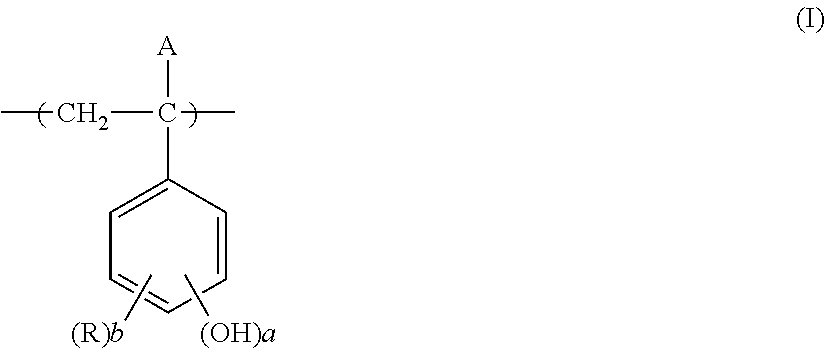Resist pattern forming method, resist pattern, crosslinkable negative resist composition, nanoimprint mold and photomask
a technology of resist pattern and crosslinkable negative resist, which is applied in the field of resist pattern forming method, crosslinkable negative resist composition, nanoimprint mold and photomask, can solve the problems of unsatisfactory resolution performance of ultrafine pattern and good nanoedge roughness at present, and achieve high resolution, high sensitivity, and high resolution.
- Summary
- Abstract
- Description
- Claims
- Application Information
AI Technical Summary
Benefits of technology
Problems solved by technology
Method used
Image
Examples
synthesis example 1
Synthesis of Polymer-3
[0265]In 120 mL of tetrahydrofuran (THF), 20 g of poly(p-hydroxystyrene) (VP2500) produced by Nippon Soda Co., Ltd. was dissolved, and 4.96 g of 1-adamantanecarbonyl chloride and 3.37 g of triethylamine were added thereto. The mixture was stirred at 50° C. for 4 hours, and the reaction solution was returned to room temperature. Thereafter, 100 mL of ethyl acetate and 100 mL of distilled water were added thereto and while stirring the reaction solution in ice water, an aqueous 1 N HCl solution was added little by little to the reaction solution to effect neutralization. The reaction solution was transferred to a separating funnel, and 100 mL of ethyl acetate and 100 mL of distilled water were further added. After stirring, the aqueous layer was removed, and the organic layer was washed with 200 mL of distilled water five times. The organic layer was then concentrated and added dropwise to 2 L of hexane. The powder after filtration was collected and vacuum-dried ...
examples 13 to 15
[0295]Resist patterns were formed and evaluated by the same operation as in EB Exposure Evaluation 1 except for applying the prepared negative resist solution on a Cr oxide film-deposited 6-inch wafer. The conditions for pattern formation and the evaluation results of each pattern are shown in Tables 6 and 7.
[0296]
TABLE 6DeveloperThickness ofAlkaliResistBaking ConditionsAlkaliConcentrationMode ofDevelopmentCompositionFilm CoatedAfter CoatingAfter ExposureSpecies(mass %)DevelopmentTimeExample 13Composition 130 nm150° C. × 90 sec110° C. × 90 secTMAH1.0%shower120 secExample 14Composition 230 nm150° C. × 90 sec110° C. × 90 secTMAH0.8%shower180 secExample 15Composition 130 nm150° C. × 90 sec110° C. × 90 secTMAH0.6%shower500 sec
[0297]
TABLE 7Sensitivity(μC / cm2)Resolution (nm)LER (nm)Pattern ProfileExample 13100204.5AExample 1490204.2AExample 1580204.0A
[0298]It is seen from the results in Table 7 that the resist pattern forming method according to the present invention is applicable also to...
examples 16 to 18
[0299]Exposure was performed using EUV light (wavelength: 13 nm) through a 1:1 line-and-space mask pattern with a line width of 30 nm. Coating of resist and development were performed by the same operation as in EB Exposure Evaluation 1, and the formed resist pattern was subjected to the same evaluations except for resolution. The conditions for pattern formation and the evaluation results of each pattern are shown in Tables 8 and 9.
[0300]
TABLE 8DeveloperThickness ofAlkaliResistBaking ConditionsAlkaliConcentrationMode ofDevelopmentCompositionFilm CoatedAfter CoatingAfter ExposureSpecies(mass %)DevelopmentTimeExample 16Composition 130 nm150° C. × 90 sec110° C. × 90 secTMAH1.0%shower120 secExample 17Composition 230 nm150° C. × 90 sec110° C. × 90 secTMAH0.8%shower180 secExample 18Composition 130 nm150° C. × 90 sec110° C. × 90 secTMAH0.7%shower500 sec
[0301]
TABLE 9Sensitivity (mJ / cm2)LER (nm)Pattern ProfileExample 16254.5AExample 17244.2AExample 18244.0A
[0302]It is seen from the results ...
PUM
| Property | Measurement | Unit |
|---|---|---|
| thickness | aaaaa | aaaaa |
| width | aaaaa | aaaaa |
| thickness | aaaaa | aaaaa |
Abstract
Description
Claims
Application Information
 Login to View More
Login to View More - R&D
- Intellectual Property
- Life Sciences
- Materials
- Tech Scout
- Unparalleled Data Quality
- Higher Quality Content
- 60% Fewer Hallucinations
Browse by: Latest US Patents, China's latest patents, Technical Efficacy Thesaurus, Application Domain, Technology Topic, Popular Technical Reports.
© 2025 PatSnap. All rights reserved.Legal|Privacy policy|Modern Slavery Act Transparency Statement|Sitemap|About US| Contact US: help@patsnap.com



